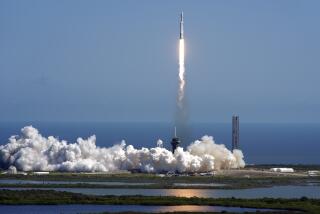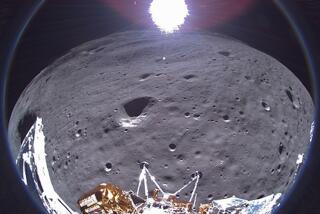European Mars satellite enters orbit to cheers, but fate of lander is unclear
- Share via
Wednesday turned up a mixed bag so far for the European Space Agency’s ExoMars 2016 mission: The agency’s Trace Gas Orbiter successfully entered orbit around the Red Planet, even as the fate of its Schiaparelli lander remained unknown.
“We need more information,” Paolo Ferri, head of ESA’s mission operations department, said at mission control in Darmstadt, Germany. “It’s clear that these are not good signs, but we need more information.”
Launched March 14, ExoMars 2016 is a two-part mission to put a satellite into orbit around Mars while also sending a lander down to its surface. The lander, Schiaparelli, is not meant to survive for long on the surface; its main function is to test out entry, descent and landing technologies that would be used by a more ambitious ExoMars mission in 2020 that would search for signs of life.
Still, Schiaparelli did carry a small scientific payload that it could use to study dust storms and other aspects of the planet’s weather, until its batteries ran out within a few days of touchdown.
The lander separated from the orbiter on Sunday, three days before both spacecraft arrived at Mars. Its entry, descent and landing sequence, dubbed the ‘six minutes of terror’ (in apparent homage to the NASA’s 2012 rover Curiosity), would test several technologies to be used with future Martian missions. The system was designed to take the spacecraft from about 13,000 mph to a halt in just six minutes — using, among other tools, a heat shield, a giant parachute and a “crushable structure” to cushion its final short drop to the ground.
The lander was set to enter the Martian atmosphere around 7:42 a.m. Pacific time, and all seemed to be going well in the control room until the final stages of the process, officials said.
“We saw the signal through the atmospheric phase — the descent phase,” Ferri said. “At a certain point, it stopped. This was unexpected, but we couldn’t conclude anything from that because, again, this very weak signal picked up from ground was coming an experimental tool.”
But data from the Mars Express orbiter echoed what the preliminary data told them — that the signal from the spacecraft seemed to stop before it landed.
Scientists had hoped for a successful European lander; Britain’s Beagle 2 spacecraft, which hitched a ride with ESA’s Mars Express, disappeared during its 2003 landing (and was finally rediscovered in early 2015). The current pantheon of successfully operating rovers and landers were all sent by NASA; these include Curiosity and the 2004 twin rovers, Spirit and Opportunity.
Mission control was more upbeat after learning that the Trace Gas Orbiter slipped into orbit without a hitch around 8:24 a.m. Pacific — flight director Michel Denis pumped his fist in the air and cheered as scientists and engineers applauded.
“It’s all good,” Denis said. “It’s a good spacecraft at the right place, and we have a mission around Mars – another one.”
The orbiter joins its fellow European satellite, Mars Express, India’s Mangalyaan and three operational NASA spacecraft in orbit — 2001 Mars Odyssey, Mars Reconnaissance Orbiter and MAVEN.
The new orbiter, called TGO for short, will probe the Martian atmosphere for tiny amounts of airborne chemicals that could provide hints of biological or geological activity on the now-dry, dusty planet. The spacecraft will look for methane, for example, because much of Earth’s supply is produced by living things.
In the meantime, mission officials say they hope to have a clearer answer on the ultimate fate of Schiaparelli by Thursday morning.
“This landing was a test, and as part of the test, you want to know what happened,” Ferri said.
ALSO
Wild monkeys make sharp stone tools, but they might not realize it, scientists say
See how beautiful the world can look through a microscope
5,000 years ago, rodents were apparently considered food in part of Europe
UPDATES:
11:45 a.m.: This article has been updated with an official saying the probe’s signal cut off before landing.
11:16 a.m.: This article has been updated with the status of the probe’s touchdown and additional background
This story was originally posted at 10 a.m.







